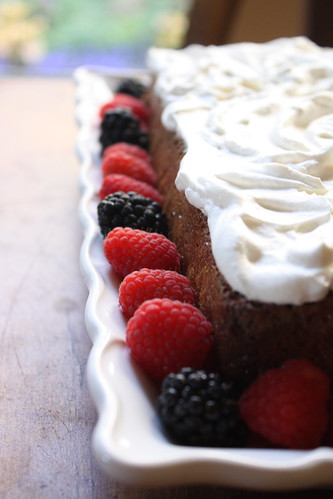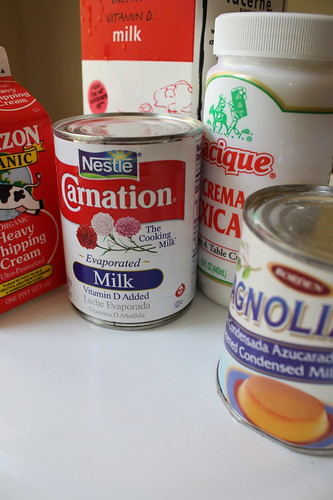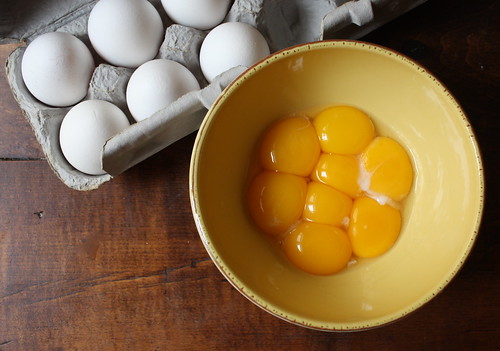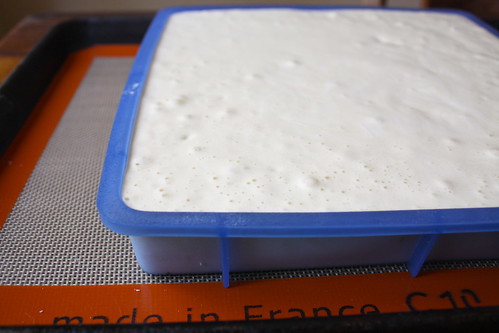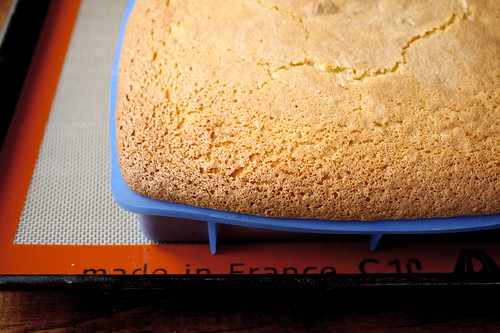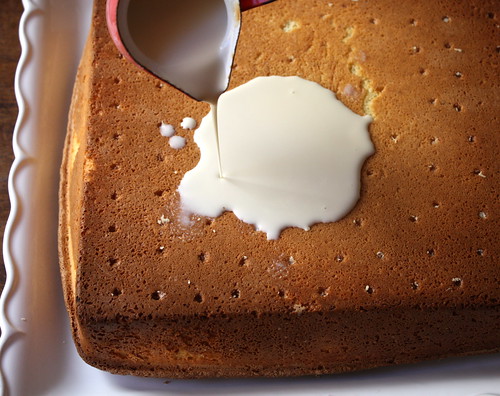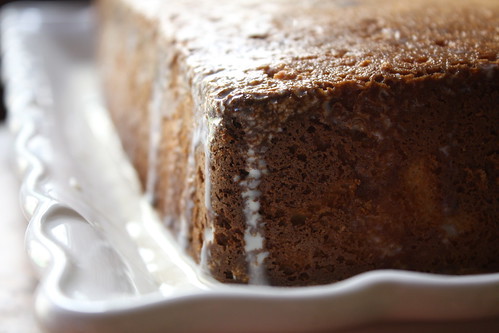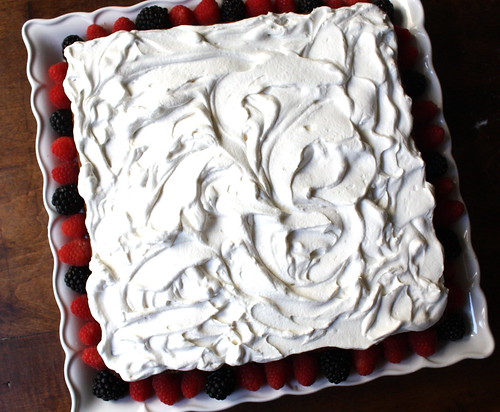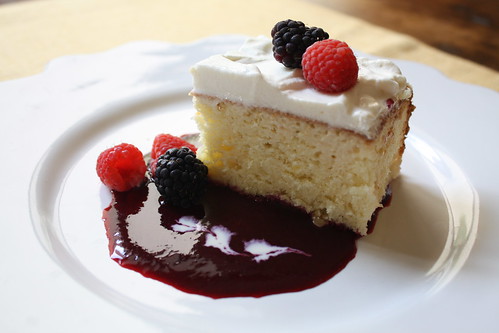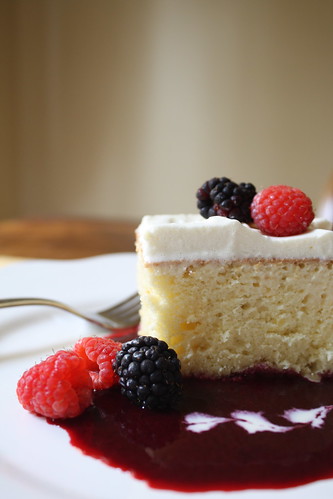Quatro Leches Cake with Blackberry Sauce
I’m notorious for rarely making a recipe more than once. I have been known, however, to make a dish again and again with a new recipe each time. I know this isn’t a novel concept, and I guess some may consider it crazy. For example: You’ve been invited to a dinner party and you’ve volunteered to make dessert. Because the menu is featuring Mexican cuisine, for a split second, you’re tempted to try Budin de Cajeta con Moras you tried last time the dinner group got together for Mexican, but no, because you saw a recipe for flan with hazelnuts in a recent issue of Food & Wine. Of course time got away from you (better known as procrastination) so you relied yet again upon Google and a search for Tres Leches knowing something new would come up.
Of course it did. I’ve made Tres Leches cake, and Quatro Leches cake but this one seemingly had a different spin, so how could I resist?
I couldn’t. This cake wasn’t destined to stay in the pan while the milk was poured over it. No, it needed to be turned out of its pan, cooled, flipped, and then subjected to the milk bath. Yes, I had to find out what could happen.
Murphy’s Law.
This recipe actually contains five kinds of milk, but the whole milk goes into the cake batter instead of in the mix that is poured onto the cake after it’s finished baking. That’s where the quatro comes from instead of the more traditional tres. The fourth milk here is Crema Mexicana. It’s a thick cream that has a slight tang to it — slightly similar to that of yogurt, but nothing like sour cream. Although there is no butter in the cake, there are eight eggs used to create the large layer of sponge. The egg whites are whipped until nearly marshmallow-like in consistency.
Although the recipe calls for a 9″ x 13″ glass or metal pan, I prefer the look of a square cake so pulled one of my 10-1/2″ silicone pans from the cupboard. A simple mental comparison of the area of each pan told me it would be close, but fine. Plus, I knew that a sponge doesn’t rise all that much so I wouldn’t have to worry about cake oozing over the sides of the pan.
I nearly always choose convection settings when I bake and am supposed to reduce the oven temperature by as much as 25 degrees, but never have followed that rule. Usually, I decrease it by 5 degrees, and expect to bake my goods anywhere from 5-10 minutes less.
This cake baked for 25 minutes and I had to return it to the oven, checking it in 5-minute segments until the center was firm, and had a spring to it when gently pressed — about 40 minutes. Ten minutes of resting time in the pan preceded a direction I questioned: “Place rack on top of dish and turn over to release. Allow cake to cool upside down for another 20-30 minutes.” In my experience, a warm cake resting against a flat surface builds up moisture and tends to stick to the plate, but I followed the directions.
Of course it stuck, so I flipped it back over and continued on as if nothing had happened after I singed my husband’s ears with a few choice vocabulary words. Using a wooden skewer, I poked holes across the entire surface.
While the cake was conspiring to stick to the plate cooling, I prepared the quatro leches mixture. Slowly, I poured it over the cooled layer waiting until it soaked in until pouring more over.
Occasionally, I used an off-set spatula to gently coerce the liquid to the edge of the cake, allowing it to dribble over the edges and soften the sponge.
This cake was supposed to have chilled over night or at least four hours, but I only had a few before I was supposed to take it to a dinner party. So I cranked up the chill setting in the fridge, popped it in well-wrapped and hoped for the best.
While the cake was chilling, I prepared the berry puree and the whipped topping, deciding when it was time to ice the cake I’d only swirl it on the top. Since the milk hadn’t quite been absorbed in the time I had, I decided to line the berries up against the sides to hide the pool of milk.
There wasn’t enough room in the fridge to keep the cake chilled before we were ready to eat it, but it held up perfectly. Rave reviews all ’round on this one. No question about it — truly a lovely, lovely dessert: moist but not remotely soggy, and a perfect balance of tart and sweet between the cake and the raspberry puree.
Thankfully, I had a few pieces left to take photos. Of course we had them for breakfast the next morning. Completely sinful. The recipe for this fabulous version of the traditional Tres Leches Cake is available at SFGate.
If I had it to do all over again, I’d…
- probably use the rectangular pan as called for in the recipe. The square is beautiful, but it’s no big deal.
- turn the cake out of the pan after the short cooling, then continue to cool it right side up to avoid the sticking.
- use 1 cup of Crema Mexicana instead of splitting it with heavy cream. I like tang. Of course if you can’t get Crema Mexicana, then you could experiment with Creme Fraiche or just use heavy cream. Mascarpone? Oh!
- make sure enough time is allowed to chill it over night. Although it was truly great, the next morning, all the milk was completely absorbed and the texture of the cake was incredible. Plus, it’s just nice chilled.
- try a different fruit puree. Blackberries were wonderful, but I’m wondering about other flavors now, of course. Like peaches.
And then there are the dulce de leche possibilities….with apples. *swoon*
